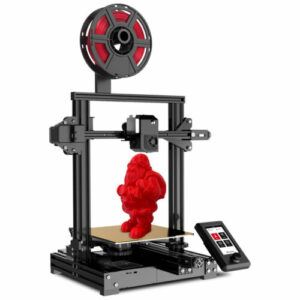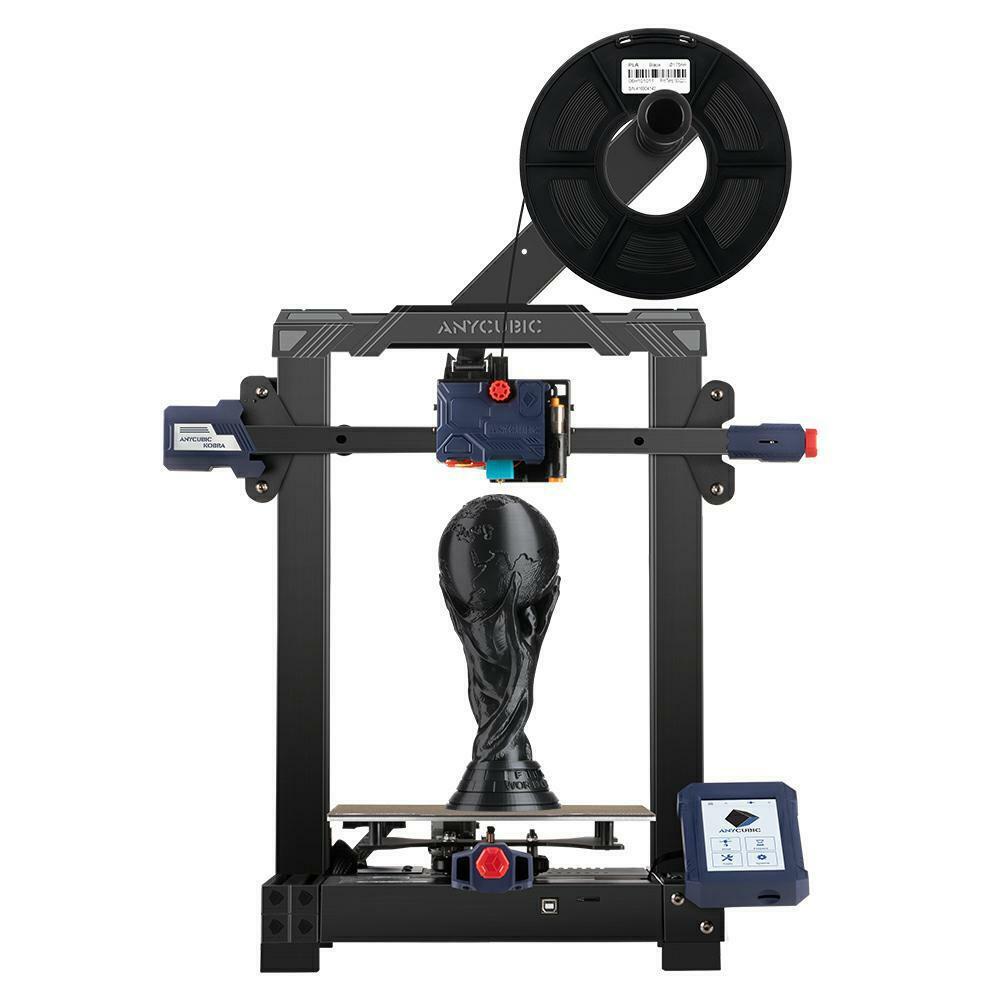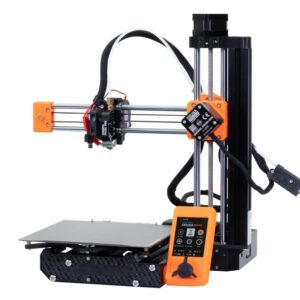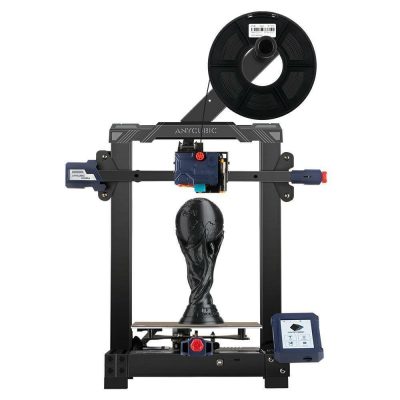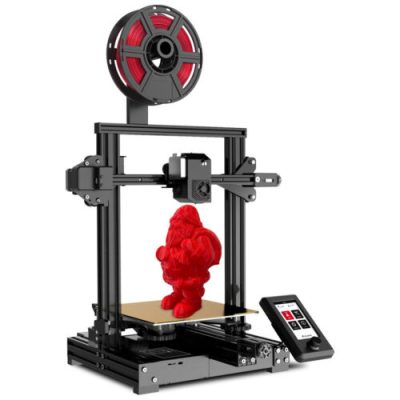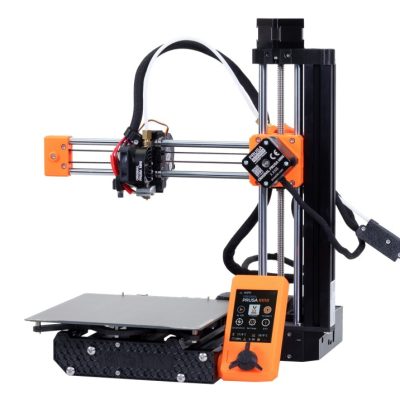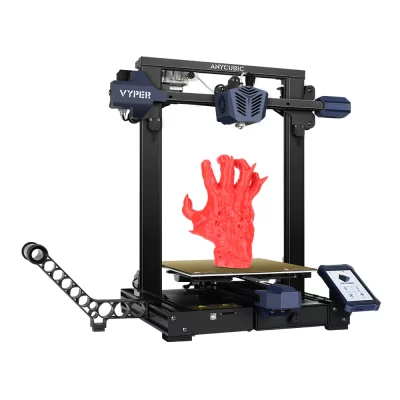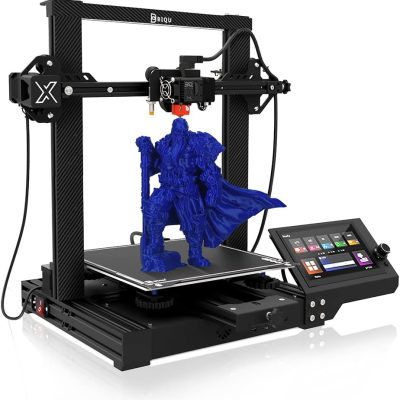- Last Updated: January 12, 2024
-
 Jackson O'Connell
Jackson O'Connell
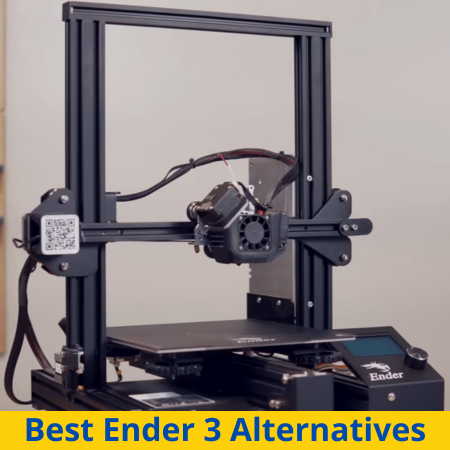 We’ve all heard of the Creality Ender 3, perhaps the most popular printer among 3D printing hobbyists and enthusiasts. It’s super affordable and performs just as well as many $500+ machines, especially when upgraded with the many different mods designed by the community.
We’ve all heard of the Creality Ender 3, perhaps the most popular printer among 3D printing hobbyists and enthusiasts. It’s super affordable and performs just as well as many $500+ machines, especially when upgraded with the many different mods designed by the community.
But, today, the Ender 3 isn’t the only low-cost, high-value printer on the market. And it’s not always the best option.
Moreover, since the Ender 3’s initial success, many other companies have developed their own high-value printers to rival the Creality Ender 3 (Pro/V2/S1). While these Ender 3 “knock-offs” each offer different features and printing performance, they all share two main similarities: an i3-style frame and a super low price point.
Some of my favorite Ender 3 alternative printers are the Anycubic Kobra and Prusa Mini+. Both machines bring many high-quality features, like automatic bed leveling and a spring steel build plate, that the original Ender 3 doesn’t have.
Want to hear about more of the best Ender 3 alternatives? Just keep reading!
Best Ender 3 Alternatives in 2024
1. Anycubic Kobra (Best Choice)
2. Voxelab Aquila S2 (Best Value)
3. Prusa Mini+ (Premium Choice)
4. Anycubic Vyper
5. Biqu BX
Printer Type: FDM | Layer Resolution: 0.05 – 0.3 mm | Materials: PLA, ABS, PETG & TPU | Build Volume: 220 x 220 x 250 mm | Max Print Speed: 180 mm/s | Bed Temperature: 110°C
Our first Ender 3 alternative is the Anycubic Kobra, a printer I’ve reviewed personally and found to be the best direct drive printer under $250. Developed by Anycubic, another popular Chinese 3D printer manufacturer, the Kobra costs as much as the Ender 3 V2, but has many of the same features as the higher-end Ender 3 S1.
The most notable feature of the Anycubic Kobra is its direct drive printhead, which enables high-quality printing in flexible filament materials like TPU, something the original Ender 3 always struggled with. Moreover, the Kobra’s printhead reminds me a lot of the popular E3D Hemera, as it’s both compact and powerful, with a 3:1 gear ratio that ensures accurate and reliable extrusion.
Plus, attached to the printhead is an inductive automatic bed leveling (ABL) sensor that makes achieving a high-quality first layer a breeze. Auto bed leveling is a feature Creality held back from the Ender 3 for quite some time, and it makes the whole 3D printing experience so much better. Not only do ABL sensors ensure a high-quality, even first layer, but having one also means you don’t have to spend 5-10 minutes before each print job manually leveling the bed.
Other notable features on the Anycubic Kobra not seen on the original Creality Ender 3 include a touchscreen LCD to make the printer easy to use, integrated belt tensioners for preventing layer shifting, and a 32-bit motherboard with easy firmware flashing.
Overall, if you’re looking for the best Ender 3 alternative, it’s no question that the Anycubic Kobra should be on your radar. It costs just $20 more than the original Creality Ender 3 but brings you practically every feature you could possibly want from a budget 3D printer, from ABL to a touchscreen LCD.
Pros
- Touchscreen LCD
- Integrated belt tensioners
- Spring steel PEI print bed
- Compact printhead
- Auto bed leveling
- 32-bit motherboard
Cons
- Closed V-slot extrusions (more difficult to mod)
- Non-modular printhead
Printer Type: FDM | Layer Resolution: 0.1 – 0.4 mm | Materials: PLA, ABS, PLA-CF, PETG, PETG-CF, PA12-CF, PA, PC & TPU | Build Volume: 220 x 220 x 240 mm | Max Print Speed: 180 mm/s | Bed Temperature: 100°C
Another excellent Ender 3 alternative is the Voxelab Aquila S2. This printer is an updated variation of Voxelab’s original Aquila printer and is easily one of my favorite options on this list due to its material capabilities.
The printer has a maximum hot end temperature of 300 °C, and it uses a direct drive extruder. With these two elements combined, you can feasibly print most consumer-grade filament materials, including PLA, ABS (with enclosure), PETG, TPU, TPE, Nylon, and even PC.
And the printer is also known to be decently reliable. The printhead, while a bit larger and more blocky than other manufacturers’ designs, uses a large NEMA stepper motor to offer powerful filament extrusion to prevent issues like clogging and under-extrusion.
Additionally, like some of the other printers I talked about, the Aquila S2 has a full-color LCD with a custom interface that makes using the machine a breeze. And, with a 32-bit motherboard, you won’t see any lagging when using the LCD or during the printing process.
The Voxelab Aquila S2 is also open-source so you can design and implement whatever mod or upgrade, whether physical or digital, that you want. It’s a hobbyist’s dream!
Pros
- Integrated belt tensioners
- Spring steel PEI print bed
- Compact printhead
- Powerful extrusion
- Auto bed leveling
- 32-bit motherboard
Cons
- Closed V-slot extrusions (more difficult to mod)
- Blocky and visually unappealing printhead
- Blocky and visually unappealing printhead
Printer Type: FDM | Layer Resolution: 50 microns | Materials: PLA, PETG, ASA, ABS, Polycarbonate, CPE, PVA/BVOH, PVB, HIPS, Polypropylene, Flex, nGen, Nylon & Woodfill | Build Volume: 180 x 180 x 180 mm | Max Print Speed: 200 mm/s | Bed Temperature:100°C
It’s hard to look for a 3D printer and not hear about Prusa, the famed Czechian manufacturer responsible for the original Prusa i3 printer. The Prusa Mini+ is Prusa Research’s least expensive machine and it makes for the perfect Ender 3 alternative.
Although the Prusa Mini+ is a bit smaller, offering only 180 x 180 x180 mm of build volume compared to the Ender 3’s 220 x 220 x 250 mm, this is still enough space to make most models you’d find on Thingiverse. Despite its lacking size as well as its higher price tag (~$450), the Prusa Mini+ still is one of the best options for an Ender 3 alternative because of its reliability.
Furthermore, the Prusa Mini+, like most Prusa printers, is renowned in the 3D printing community for being extremely reliable and yielding consistently high-quality prints. I dare you to look up a Prusa Mini+ print and compare it to a typical Ender 3 print; it’s no competition! And this stems from Prusa’s tight manufacturing processes and careful part selection.
For example, all of the metal components on the Prusa Mini+ are noticeably higher quality and more rigid than the bottom-of-the-bucket aluminum that you might see on a Creality printer (sorry Creality but it’s true). And Prusa used an E3D hot end on the Mini+, so the temperature control and extrusion are very reliable.
Additionally, Prusa develops firmware for the Prusa Mini+ in-house and heavily tests new features before giving them to the public.
Some other noteworthy features of the Prusa Mini+ are its spring steel PEI build plate, full-color LCD, and conduit rail motion system for smoother movements.
So, if you’re looking for an Ender 3 alternative that will consistently bring you high-quality 3D prints, it’s hard to find a better option than the Prusa Mini+. While it’s got a smaller build volume, a less stable frame, and a higher price point than the Ender 3, all its features make it very worthwhile.
Pros
- Large community
- Spring steel PEI print bed
- Impressive reliability and quality
- Auto bed leveling
- Smooth motion system
- 32-bit motherboard
- Stable and feature-full firmware
Cons
- LCD isn’t touchscreen
- Bowden extruder
- Smaller build volume
- Less stable frame
Printer Type: FDM | Layer Resolution: 0.1 mm | Materials: PLA, ABS, PETG, TPU & Wood | Build Volume: 245 x 245 x 260 mm | Max Print Speed: 180 mm/s | Bed Temperature: 110°C
Another terrific Ender 3 alternative from Anycubic is the Vyper. The Vyper is a bit older than its brother, the Anycubic Kobra, so its features might seem a bit more archaic. However, to this day, the Anycubic Vyper is one of the most reliable printers I’ve ever used, making it a worthy competitor to the Creality Ender 3.
For me, the best part about the Anycubic Vyper is its overall frame and design. The printer, which follows a traditional i3-style, features dual Z-axis rods for stable vertical movement, leading to good-quality prints. Additionally, Anycubic chose to place the spool holder on the side of the machine rather than the top, thus reducing wobbling and related printing issues (e.g. ringing).
Additionally, unlike the Biqu BX and Aquila S2, the Anycubic Vyper doesn’t have a direct drive printhead; instead, it uses a Bowden-style extruder like the original Ender 3. But don’t be confused; the Bowden extruder on the Vyper is much, much superior to the setup on the original Ender 3. Moreover, the Vyper’s extruder was designed after the famous E3D Titan extruder and uses a 3:1 gear ratio with multiple drive gears to ensure powerful extrusion force, despite the distance between the extruder motor and the nozzle.
As for the electronics, the Vyper is a beast, with a powerful and very silent 32-bit motherboard that’s much better than even the board used on the Ender 3 V2. Plus, the Vyper comes with a HD, full-color, and touchscreen LCD that, with its custom GUI, makes using the machine easy and fun.
So, if you’re in the market for a printer that’s superior to the Ender 3 but with a similar price tag, look no further than the Anycubic Vyper!
Pros
- Touchscreen LCD
- Spring steel PEI print bed
- Powerful Titan-style extruder
- Tool drawer
- Auto bed leveling
- 32-bit motherboard
Cons
- Closed V-slot extrusions (more difficult to mod)
- Non-modular printhead
- Bowden-style extruder (can’t handle flexibles)
Printer Type: FDM | Layer Resolution: 0.1 -0.3 mm | Materials: PLA, TPU, TPE, PETG, ABS & Nylon | Build Volume: 250 x 250 x 250 mm | Max Print Speed: 100 mm/s | Bed Temperature:100°C
When it comes to seeking an Ender 3 alternative that will surely catch your attention, let me introduce you to the Biqu BX 3D printer. This nifty machine, though not as popular as some of the other options on this list, packs a punch in terms of features and functionality, making it a worthy contender in the 3D printing arena.
My favorite feature of the BX is its high-definition touchscreen LCD, which runs Biqu’s custom-designed GUI. I’m not kidding when I say even a five-year-old could navigate this interface and use the BX; that’s how good it is! From fine-tuning the extruder steps to setting temperatures, every button on the GUI looks nice, feels nice, and runs smoothly.
Now, I must admit, the Biqu BX does come with a slightly higher-than-normal price point. And its cable management is a bit…lacking. But what I think makes up for these flaws is the Biqu BX’s compact and powerful printhead.
The printhead on the BX is entirely Biqu’s design and it takes a surprisingly small amount of space. But don’t let this fool you; the BX’s extruder is very powerful and extrusion issues shouldn’t be a problem. And, because its direct drive and has a maximum temperature of 260 °C, you’ll be able to print PLA, PETG, TPU, TPE, and even ABS (with an enclosure).
Pros
- Touchscreen LCD with easy-to-use interface
- Magnetic print bed
- Auto bed leveling
- 32-bit motherboard
Cons
- Closed V-slot extrusions (more difficult to mod)
- Non-modular printhead
- Not very popular
- The LCD sticks out
Other Creality 3D Printers
Of course, the Ender 3 isn’t the only machine that Creality makes, and some of the company’s other printers make for excellent alternatives. I’ve listed and briefly gone my favorite Creality 3D printers that you might be interested in instead of an Ender 3:
- CR-6 SE: While it had a rocky release on Kickstarter, it’s hard to deny that the CR-6 SE wasn’t one of the best printers Creality ever came up with. It’s got a more hefty price tag than the Ender 3, but it’s got a nozzle-integrated bed leveling system, a powerful extruder, laser end stops for precise movement, and dual Z-axis rods.
- Ender 5 S1: With its sturdy frame and impressive features, the Ender 5 S1 stands out as a remarkable 3D printer. Despite its slightly higher price tag than the Ender 3 (Pro/V2/S1), the Ender 5 S1 delivers outstanding performance, with the same Creality Sprite print head as the Ender 3 S1, offering auto bed leveling, high-temperature capabilities, and reliable extrusion. Plus, the Ender 5 is a bit more spacious with a slightly larger build volume to allow you to print even larger models.
- Sermoon D1: Lastly, the Creality Sermoon D1 is a rather new Creality printer that comes with a built-in enclosure to enable you to print higher-temperature materials like ABS and nylon. On top of its sleek, transparent enclosure, the Sermoon D1 has a touchscreen and easy-to-use LCD, a Bowden-style extruder, a filament runout sensor, and a handful of other useful features. Plus, it’s not too expensive, especially considering that it’s enclosed.
- CR-6 SE: While it had a rocky release on Kickstarter, it’s hard to deny that the CR-6 SE wasn’t one of the best printers Creality ever came up with. It’s got a more hefty price tag than the Ender 3, but it’s got a nozzle-integrated bed leveling system, a powerful extruder, laser end stops for precise movement, and dual Z-axis rods.
Why Look for an Alternative for Creality Ender 3?
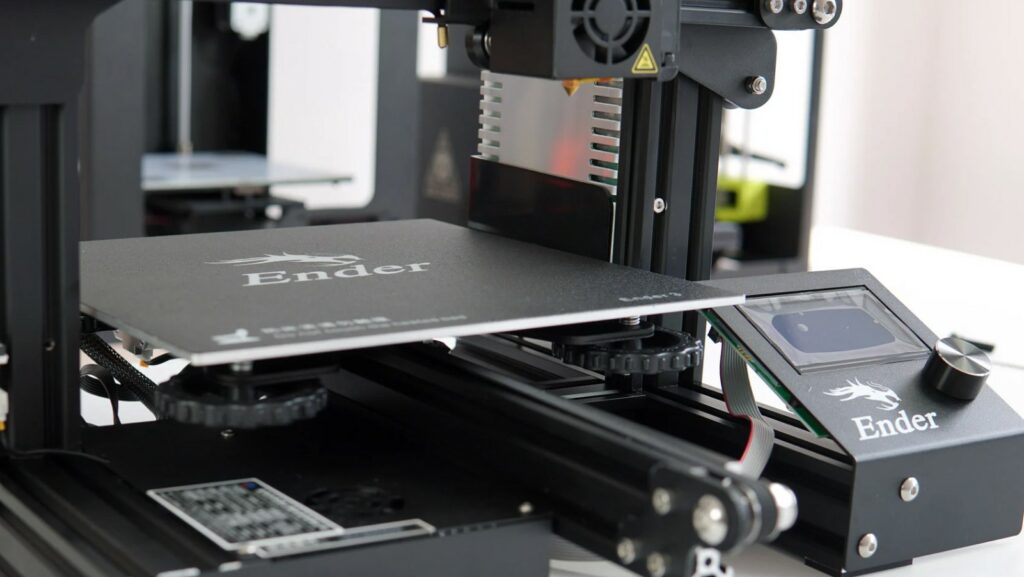
The main reason you might want to find an alternative printer to the Ender 3 is to get newer features. The original Creality Ender 3 came out all the way back in 2018, and, since then, many features previously considered “higher-end” have become normal for low-cost 3D printers.
As such, the Creality Ender 3 is no longer the best bang for your buck, and you might be interested in finding an alternative. Some of the features that you can find on Ender 3 alternatives include auto bed leveling, a filament runout sensor, PEI build plate, and dual Z-axis rods.
Another reason you might want to find an alternative to the Creality Ender 3 is to get away from the increasingly closed-source environment that Creality facilitates. Moreover, as Creality has grown as a company, they’ve focused less on keeping their printers (e.g. Ender 3 S1) open-source and this can make upgrading these machines more difficult. Luckily, you can find many printers similar to the Ender 3 that are made by companies more focused on keeping their machines open-source (e.g. Prusa).
Considerations for Ender 3 Alternatives
When looking for an Ender 3 alternative, there are a few relevant factors to consider. I’ve explained the most important ones in the sections below.
Print Quality
The most important consideration for an Ender 3 alternative 3D printer is the print quality. Print quality is simply the quality of the 3D prints that a machine can produce. Obviously, better print quality will mean your printer is able to handle more heavily detailed and intricate part designs.
However, because so many different small features and factors influence print quality (e.g. temperature stability, bed leveling), it’s difficult to evaluate the print quality of a specific machine. As such, I recommend looking at user reviews to see how other users think the machine performs.
Build Volume
The build volume of a printer is the amount of space you can 3D print models in. The larger the build volume, the larger the parts you can print, so obviously a larger volume is better. But, as you might expect, larger 3D printers cost more, so there is a trade-off.
I recommend getting a printer with at least a print volume of 200 x 200 x 200 mm. This much space will allow you to print most 3D models on Thingiverse, like trinkets, fidgets, gears, and other parts. Plus, most printers with a print volume of around 200 x 200 x 200 mm won’t be super expensive.
Extra Features
Another important consideration for Ender 3 alternatives is their extra features. I like to think of “extra features” as features that are small and not too significant but still improve the machine’s usability or printing performance. Examples of extra features include an automatic bed leveling sensor, spring steel PEI build plate, filament runout sensor, 32-bit motherboard, and more.
When a manufacturer spends the time and money to include these “extra features” into a machine, you can tell they spent an adequate amount of time developing the machine and that it’s no bottom-of-the-bucket printer.
Cost
Finally, you should consider the cost of a machine. If you’re in the market to buy a 3D printer, I recommend setting a budget, somewhere between $200 and $500, and then finding a machine in this price range.
I can tell you from personal experience that looking for a 3D printer without a budget will almost always result in you justifying a higher-end printer even when it’s not needed.
Conclusion
Overall, the Creality Ender 3 is easily one of the most popular 3D printers nowadays. And while it reigned over the hobbyist community for years, it’s no longer the best value 3D printer and many other options exist with superior features and a similar price point.
My favorite Ender 3 alternative is the Anycubic Kobra. It costs just $20 more than the OG Creality Ender 3, but has many of the same features as modern $400+ printers, including an auto bed leveling sensor, spring steel PEI print bed, belt tensioners, a touchscreen LCD, and more!
If you’re looking for a printer that’s more reliable and yields great print quality, especially compared to the Ender 3, you should consider the Prusa Mini+. While this Ender 3 alternative is a bit pricier than most, it is built with only high-quality components and Prusa puts a lot of effort into the firmware development to ensure it maintains a high level of quality for prints, day after day.
Hope this helps in your search! Enjoy!




